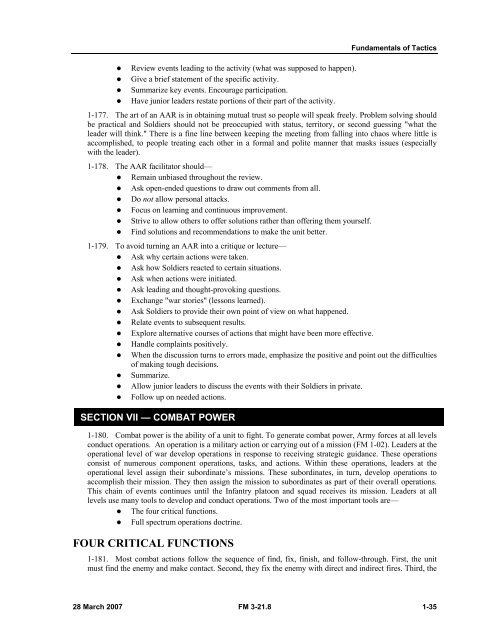Infantry Rifle Platoon and Squad - Sakai
Infantry Rifle Platoon and Squad - Sakai
Infantry Rifle Platoon and Squad - Sakai
Create successful ePaper yourself
Turn your PDF publications into a flip-book with our unique Google optimized e-Paper software.
• Review events leading to the activity (what was supposed to happen).<br />
• Give a brief statement of the specific activity.<br />
• Summarize key events. Encourage participation.<br />
• Have junior leaders restate portions of their part of the activity.<br />
Fundamentals of Tactics<br />
1-177. The art of an AAR is in obtaining mutual trust so people will speak freely. Problem solving should<br />
be practical <strong>and</strong> Soldiers should not be preoccupied with status, territory, or second guessing "what the<br />
leader will think." There is a fine line between keeping the meeting from falling into chaos where little is<br />
accomplished, to people treating each other in a formal <strong>and</strong> polite manner that masks issues (especially<br />
with the leader).<br />
1-178. The AAR facilitator should—<br />
• Remain unbiased throughout the review.<br />
• Ask open-ended questions to draw out comments from all.<br />
• Do not allow personal attacks.<br />
• Focus on learning <strong>and</strong> continuous improvement.<br />
• Strive to allow others to offer solutions rather than offering them yourself.<br />
• Find solutions <strong>and</strong> recommendations to make the unit better.<br />
1-179. To avoid turning an AAR into a critique or lecture—<br />
• Ask why certain actions were taken.<br />
• Ask how Soldiers reacted to certain situations.<br />
• Ask when actions were initiated.<br />
• Ask leading <strong>and</strong> thought-provoking questions.<br />
• Exchange "war stories" (lessons learned).<br />
• Ask Soldiers to provide their own point of view on what happened.<br />
• Relate events to subsequent results.<br />
• Explore alternative courses of actions that might have been more effective.<br />
• H<strong>and</strong>le complaints positively.<br />
• When the discussion turns to errors made, emphasize the positive <strong>and</strong> point out the difficulties<br />
of making tough decisions.<br />
• Summarize.<br />
• Allow junior leaders to discuss the events with their Soldiers in private.<br />
• Follow up on needed actions.<br />
SECTION VII — COMBAT POWER<br />
1-180. Combat power is the ability of a unit to fight. To generate combat power, Army forces at all levels<br />
conduct operations. An operation is a military action or carrying out of a mission (FM 1-02). Leaders at the<br />
operational level of war develop operations in response to receiving strategic guidance. These operations<br />
consist of numerous component operations, tasks, <strong>and</strong> actions. Within these operations, leaders at the<br />
operational level assign their subordinate’s missions. These subordinates, in turn, develop operations to<br />
accomplish their mission. They then assign the mission to subordinates as part of their overall operations.<br />
This chain of events continues until the <strong>Infantry</strong> platoon <strong>and</strong> squad receives its mission. Leaders at all<br />
levels use many tools to develop <strong>and</strong> conduct operations. Two of the most important tools are—<br />
• The four critical functions.<br />
• Full spectrum operations doctrine.<br />
FOUR CRITICAL FUNCTIONS<br />
1-181. Most combat actions follow the sequence of find, fix, finish, <strong>and</strong> follow-through. First, the unit<br />
must find the enemy <strong>and</strong> make contact. Second, they fix the enemy with direct <strong>and</strong> indirect fires. Third, the<br />
28 March 2007 FM 3-21.8 1-35

















